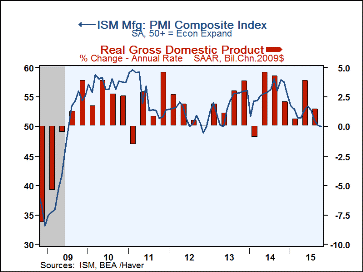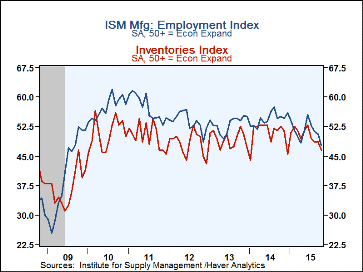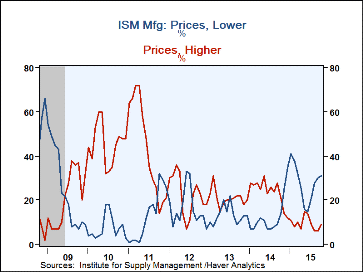 Global| Nov 02 2015
Global| Nov 02 2015U.S. ISM Factory Activity Remains Near Break-Even but Employment Declines
by:Tom Moeller
|in:Economy in Brief
Summary
Activity in the manufacturing sector was little changed last month. October's Composite Index of 50.1 from the Institute for Supply Management (ISM) compared to an unrevised 50.2 in September. A reading of 50.0 had been expected in [...]
Activity in the manufacturing sector was little changed last month. October's Composite Index of 50.1 from the Institute for Supply Management (ISM) compared to an unrevised 50.2 in September. A reading of 50.0 had been expected in the Action Economics Forecast Survey. During the last ten years, there has been a 73% correlation between the level of the index and the q/q change in real GDP
Performance amongst the component series was mixed last month. The employment series declined sharply to 47.6, the first month below break-even since April. During the last ten years, there has been an 89% correlation between the index level and the m/m change in factory sector payrolls. Also moving lower was the inventories index. It's decline to 46.5 indicated decumulation at the quickest rate since December of last year. Twenty-two percent of companies were reducing inventories, up sharply from 16% twelve months earlier, and 15% were raising them, down from 21% one year ago. The pace of supplier deliveries held fairly steady as indicated by a reading of 50.4. To the upside, the new orders index rose to 52.9, its highest level in three months. The production series improved a bit to 52.9, but was off sharply from last year's high of 63.1.
The prices reading improved slightly to 39.0, but remained down from last year's high of 60.5. Nine percent of respondents indicated higher prices while 31% reported them lower. During the last ten years, there has been an 85% correlation between the index and the m/m change in the core intermediate PPI.
The new export order index improved m/m to 47.5, but remained near the three-year low. Imports fell sharply to the 2013 lows and the order backlog series showed moderate decline.
The figures from the Institute For Supply Management (ISM) are diffusion indexes. A reading above 50 represents growth in factory sector activity. They can be found in Haver's USECON database. The expectations number is in the AS1REPNA database.
Is Monetary Policy Overburdened? from the Federal Reserve Bank of Boston is available here.
| ISM Mfg (SA) | Oct | Sep | Aug | Oct '14 | 2014 | 2013 | 2012 |
|---|---|---|---|---|---|---|---|
| Composite Index | 50.1 | 50.2 | 51.1 | 57.9 | 55.7 | 53.8 | 51.7 |
| New Orders | 52.9 | 50.1 | 51.7 | 63.0 | 59.0 | 56.9 | 52.9 |
| Production | 52.9 | 51.8 | 53.6 | 62.8 | 59.2 | 57.5 | 53.7 |
| Employment | 47.6 | 50.5 | 51.2 | 55.2 | 54.5 | 53.2 | 53.8 |
| Supplier Deliveries | 50.4 | 50.2 | 50.7 | 56.1 | 55.0 | 51.9 | 50.0 |
| Inventories | 46.5 | 48.5 | 48.5 | 52.5 | 50.8 | 49.4 | 48.2 |
| Prices Paid Index (NSA) | 39.0 | 38.0 | 39.0 | 53.5 | 55.6 | 53.8 | 53.2 |
Tom Moeller
AuthorMore in Author Profile »Prior to joining Haver Analytics in 2000, Mr. Moeller worked as the Economist at Chancellor Capital Management from 1985 to 1999. There, he developed comprehensive economic forecasts and interpreted economic data for equity and fixed income portfolio managers. Also at Chancellor, Mr. Moeller worked as an equity analyst and was responsible for researching and rating companies in the economically sensitive automobile and housing industries for investment in Chancellor’s equity portfolio. Prior to joining Chancellor, Mr. Moeller was an Economist at Citibank from 1979 to 1984. He also analyzed pricing behavior in the metals industry for the Council on Wage and Price Stability in Washington, D.C. In 1999, Mr. Moeller received the award for most accurate forecast from the Forecasters' Club of New York. From 1990 to 1992 he was President of the New York Association for Business Economists. Mr. Moeller earned an M.B.A. in Finance from Fordham University, where he graduated in 1987. He holds a Bachelor of Arts in Economics from George Washington University.










